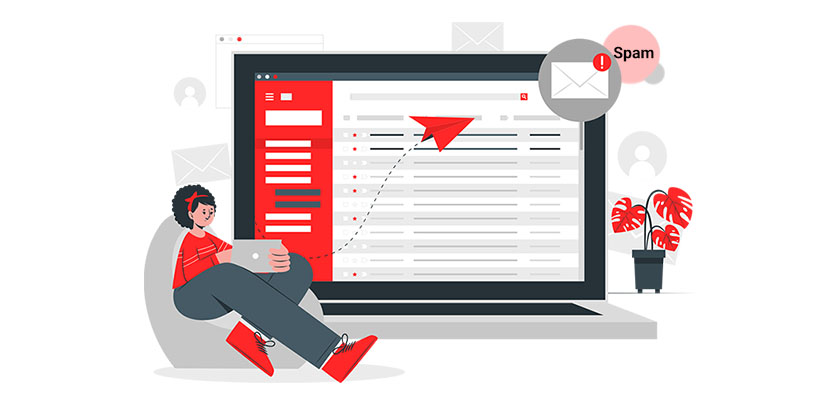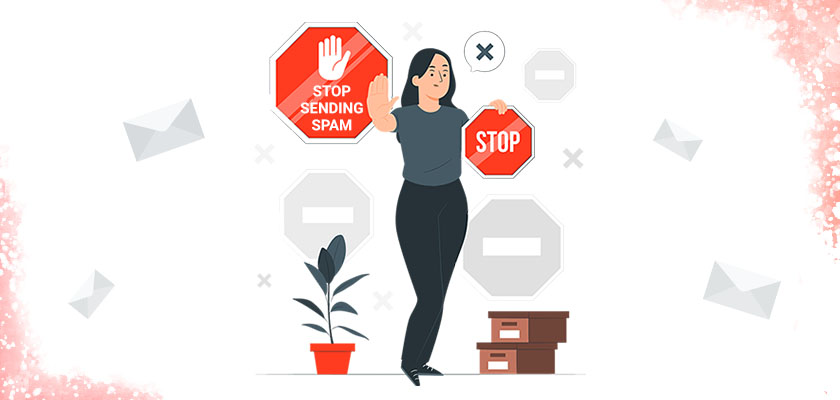How to Stop Sending Spam Emails?

You’ve probably asked yourself, “Why does my email go to spam?” Don’t worry; we have a 9-step guide to help stop your email from becoming spam.
It would be a shame for all your hard work in crafting emails to go to waste. But that is precisely what happens when an email gets lost in a subscriber’s spam folder. Return Path’s report shows that spam filters have become more strict. One in five emails fails to reach the inbox.
These statistics are alarming when you’re creating an email marketing campaign. But don’t worry–we’ve got your back. We don’t want you to lose your email addresses. In this article, we’ll discuss what is spam, how to stop spam emails and how a domain and a good VPS Server can help you to stop sending spam.
What Is Spam Email?
So, what is spam? Email spam is also known as junk mail. It refers to unsolicited emails sent to large lists of recipients in bulk. Humans can send spam. However, more often, it is sent via a botnet. This is a group of computers (bots and spambots) that have been infected by malware and are controlled by one attacker (bot herder). Spam can be sent via email, social media, and text messages.
While spam is annoying to many people, it is an expected side effect of email communication. Spam can be annoying and can cause email inboxes to become clogged if it is not removed regularly.
Spammers are email spammers who regularly modify their messages and methods to trick potential victims into downloading malicious software, sharing data, or even sending money.
Spam emails are almost always commercial and motivated by a financial goal. Spammers will try to convince recipients that they are not telling the truth, promote questionable products and make false claims.
These are the most popular subjects for spam:
- Pharmaceuticals
- Adult content
- financial services
- online degrees
- Work-from-Home Jobs
- online gambling
- cryptocurrencies
Why Does My Account Send Spam Emails?
Emails can be identified as spam for many reasons, including keywords that trigger spam filters and incorrect permissions.
Let’s look at common scenarios and see what you can do to ensure your messages reach users’ inboxes and how you can avoid sending spam emails.
1. Your Email Recipients Marked Your Emails as Spam
Your recipients are the most obvious reason your emails end up in spam.
Even if the content of your email is compelling and they have permitted you to contact them, they might still choose to mark your email spam to clear up an inbox full of junk mail.
You may have lost the reason they signed up for your mailing list or made a mistake. If enough users flag your messages, spam filters can flag your address and send your mail to spam.
Your messages could look like spam to people who haven’t flagged you previously. This is particularly true for Gmail, Outlook and Yahoo, which use heavily AI-driven algorithms.
You can’t stop someone from marking your email as spam once it has shipped.
To stop sending junk emails, make sure your content is of the highest quality and follow other best practices to avoid spamming users. This will reduce the likelihood that someone will flag your communications. These strategies will be covered in the sections below.
2. You Are not Following HTML Best Practices
Although text-only emails can be pretty straightforward, some businesses, such as eCommerce shops, may not find them viable because they could lead to lower engagement than emails that include branding and images.
It is important to use HTML in your messages to prevent emails from going to spam.
Mailchimp suggests these HTML best practices for email:
- Your maximum width should be between 600 and 800 pixels. This will ensure that your email is large enough for you to read and behaves well in the email client preview panes.
- Consider that email clients will block images and that users might not be able to see important information contained in media elements.
- CSS is the best example of keeping your code clean and simple. Avoid Flash and JavaScript. These could be considered spam vectors, as many email clients do not support Flash.
- Mobile-friendly messages are a must. It’s a good idea to make everything mobile-friendly. This means small images that don’t overwhelm mobile networks and thumb-friendly buttons. It also means email-safe fonts that can be readable on small screens.
- Fonts should be cross-platform and easily legible. There are solid choices like Georgia, Verdana and Arial.
- Check any links in your email signature. Avoid any sites that could be considered spam.
It’s wise to keep your email’s text simple and reduce the amount of HTML. Engage with your company branding and a little color, but not too much.
3. Your Subject Lines are Misleading or Contain Spam Triggers
Your subject lines are often the first impression users get of your message. They need to grab attention and encourage the reader to open the email. They must also be truthful. According to the CANSPAM Act, misleading subject lines are not only poor etiquette but also illegal.
Litmus reports that over half of respondents to emails felt cheated or tricked into opening an e-mail based on their subject line. This is a quick way for your email to be thrown into the spam folder and may lead to some users unsubscribing.
What is a misleading subject line? Here are some examples.
- RE or FW: Don’t use “RE” in your subject lines if you are actually responding to something. This is a simple trick that can quickly earn you an unsubscribe. Using “FW” to make someone think they know you can also be misleading.
- Personal messages and leading questions: Subjects such as “Did my phone go to your house?” or “Did he hear about so-and-so?” can make users wonder if they are in touch with the sender.
- Too sensational: While some subject lines may not be lies, they are often too exaggerated. You want your subject line to match the content of the email.
Professional subject lines are also important. You should not use ALL CAPS TYPE and avoid spelling or grammar mistakes. Grammarly, a free tool, can automatically check your spelling, grammar and punctuation and alert you if any problems may alert spam filters.
While you know which subject lines to avoid, you need to ensure subscribers open your messages. Hubspot offers some great tips for creating compelling headlines.
- Begin with action verbs.
- You should create a sense of urgency and importance, but don’t be misled.
- Ask a compelling or interesting question.
Remember, no matter your subject line, ensure that the content lives up to its promises. You risk ruining your reputation.
4. You Don’t Need Permission from Your Recipients
This is a simple one: Online privacy laws such as the GDPR require you to have explicit permission from recipients before you can send them emails. You cannot buy email lists to access many contacts quickly. However, this is not a good idea for other reasons, such as poor targeting.
It also means that users who give their email addresses to your site must tell you explicitly that they wish to receive emails from us, especially if they are citizens of the EU. It can be in the form of a disclaimer on your account creation page or your contact form. Or it could be a checkbox user must tick to indicate their willingness to receive emails from you.
This is a good practice; even though it may not be required for the U.S., many emails are being sent these days. If your messages suddenly start appearing in the inbox of someone who didn’t ask, it’s possible they could be considered spam.
5. Your Content Activates Spam Filters
Spam filters look for specific words or combinations of words. Spam folders can be created if an email receives enough hits or contains these words and other items on the list. Spam trigger keywords can include:
- Free
- Lowest price
- Additional income
- Easy money
- No cost
- Multiple dollar signs or exclamation marks in a row
- Unnecessary spaces and punctuation in words
- All capital letters for words
These words are usually sales-oriented or are intended to bypass spam filters (such as the extra spaces). Although a few of these words aren’t necessarily fatal, too many can spell doom for your messages.
Some keywords can be challenging to avoid, especially when sending financial or eCommerce emails. You can overcome this problem by using different languages and being creative in how you phrase things.
It’s important to avoid using pushy language or being too salesy. Also, ensure you follow the best practices for email content writing that we highlight here.
6. An Unsubscribe link is Not Necessary
The U.S. law CAN-SPAM states that emails must contain a way to unsubscribe. You must process any unsubscribe request within 10 business days. Additionally, clickers to the unsubscribe link will be notified.
This may not seem good, but it is a good thing. Why would you give people the opportunity to unsubscribe? It can have the opposite effect if your content is good. Your brand’s credibility is demonstrated by giving people an easy way out of your subscriber list.
However, it is easy to frustrate people by hiding or not offering an unsubscribe option. Negative press can result from it. Word travels fast via the internet, and people will be offended.
7. Your ‘From’ Information is Incorrect or Misleading
Incorrect ‘From’ information is a significant reason your emails could end up spam. Incorrect ‘From’ information, which tells recipients who sent the email to you, is an important reason why your emails may end up in spam. Sometimes, tools on your website, such as contact form plugins, might send spam emails that contain ‘From’ details.
The fix for spam emails in contact forms is often quite simple. Ensure the ‘From” field in your contact forms settings contains the admin address of your site and not the email address you entered. Also, ensure that the email addresses in the ‘From’ and ‘To’ fields are different if you want the contact form to send you email notifications.
8. You Haven’t Set Up Email Authentication
A common reason why your email’s ‘From’ information might be incorrect is when email authentication isn’t correctly set up through a service such as Mailchimp or one of its alternatives:
Authentication allows the service to send you emails. They will appear with your domain name attached, even though they were sent from a third party. Your emails could end up in your recipients’ spam folders if your authentication is not set up correctly.
There are a variety of methods for email authentication, including DomainKeys Identified Mail(DKIM), Sender Policies Framework (SPF), and DMARC. Or, in some cases, if you buy VPS server that is solid from a good hosting company, your emails are less likely to land in the spam folder.
DKIM is an encryption key, and digital signature used to verify email messages. SPF verifies the sender’s IP address against approved IPs. DMARC is a little different. It requires that the other two be enabled. This allows the sender to indicate that DKIM/SPF protects their email.
It’s a good idea to verify authentication if you have issues with automated email services. We have an article that will help you set up email authentication.
9. You Are Sending too Many Attachments
Most spam filters will flag attachments as a big red flag. Because files can be vectors for viruses and malware, this is why they are so important. It is best not to attach any attachments, especially in newsletters. Sending an attachment is a good idea. Make sure you let the recipient know and limit the number of attachments you send to one email.
It is safer to upload a file or document to a cloud storage site like Google Drive or Dropbox before attaching it to an email. The file can be linked-to to an email. This will ensure that your message doesn’t trigger spam filters.
How to Stop Sending Spam?

Your domain quality will affect how many emails reach your subscribers. Your email messages will be sent to spam if your domain quality (also known as sender score or sending reputation) is low. Your messages will be less likely to be deemed junk if your domain quality is high.
How Domain Quality Can Affect You
Your domain quality could be affected if a recipient marks your email as spam. The fact that your message was marked as spam will be shared with spam filters. This is known as a feedback loop. Your domain quality will be affected if a small percentage of your messages are marked spam. Spam filters will automatically mark a more significant portion of your message spam. As mentioned above, one method to avoid sending spam emails is to buy VPS hosting that has a good rate in the industry.
How to Verify the Quality of Your Domain
Talos offers a free reputation lookup tool to check the quality of your domain. Your domain quality is poor (i.e., If a certain percentage of recipients mark your emails as spam, it will take you considerable time to fix your domain quality to neutral. A low number of spam complaints is necessary to improve your domain reputation. However, spam filters will not be able to filter your messages if you have a bad domain reputation.
Spam can be very detrimental to your email communications. Send only to people who have asked for your information. You must be clear about your content and not mislead recipients. Don’t send marketing emails to anyone who hasn’t unsubscribed.
Conclusion
Spam folders can be caused by many factors, including poor subject lines and keywords that trigger spam filters. It doesn’t matter what the reason is; it’s crucial to solve the problem to maximize your return and keep your audience trusting you.
These problems can be addressed quickly, and you can prevent emails from going to spam by implementing proven best practices. These same best practices will increase the impact of your messages and help you convert more subscribers to customers. Remember that buying the best VPS hosting service with IP address with high reputation helps you not sending spam emails.

